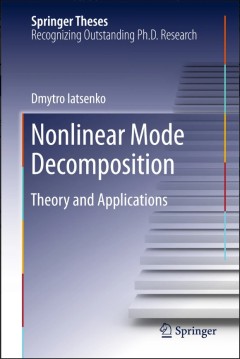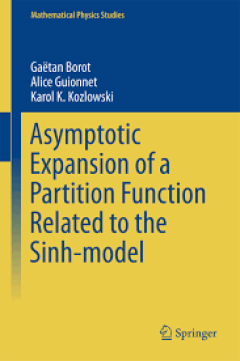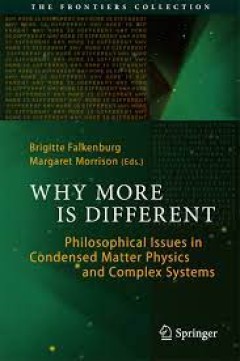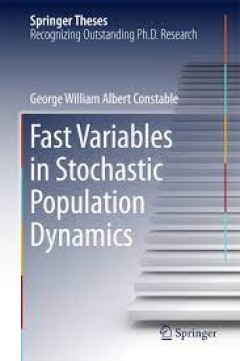Filter by

Three Domain Modelling and Uncertainty Analysis Applications in Long Range I…
This book examines in detail the planning and modelling of local infrastructure like energy systems, including the complexities resulting from various uncertainties. Readers will discover the individual steps involved in infrastructure planning in cities and territories, as well as the primary requirements and supporting quality factors. Further topics covered concern the field of uncertainty a…
- Edition
- -
- ISBN/ISSN
- 978-3-319-19572-8
- Collation
- -
- Series Title
- -
- Call Number
- -

Theory of Liquids and Other Disordered Media A Short Introduction
This set of lectures provides an introduction to the structure, thermodynamics and dynamics of liquids, binary solutions and polymers at a level that will enable graduate students and non-specialist researchers to understand more specialized literature and to possibly start their own work in this field. Part I starts with the introduction of distribution functions, which describe the statist…
- Edition
- -
- ISBN/ISSN
- 978-3-319-06950-0
- Collation
- -
- Series Title
- -
- Call Number
- -

Nonlinear Mode Decomposition:Theory and Applications
This work introduces a new method for analysing measured signals: nonlinear mode decomposition, or NMD. It justifies NMD mathematically, demonstrates it in several applications and explains in detail how to use it in practice. Scientists often need to be able to analyse time series data that include a complex combination of oscillatory modes of differing origin, usually contaminated by random f…
- Edition
- 1
- ISBN/ISSN
- 978-3-319-20015-6
- Collation
- XXIII, 135
- Series Title
- Springer Theses
- Call Number
- -

Nonlinear Maps and their Applications
In the field of Dynamical Systems, nonlinear iterative processes play an important role. Nonlinear mappings can be found as immediate models for many systems from different scientific areas, such as engineering, economics, biology, or can also be obtained via numerical methods permitting to solve non-linear differential equations. In both cases, the understanding of specific dynamical behaviors…
- Edition
- 1
- ISBN/ISSN
- 2194-1009
- Collation
- XI, 288
- Series Title
- Springer Proceedings in Mathematics & Statistics
- Call Number
- -

Analysis and Control of Complex Dynamical Systems: Robust Bifurcation, Dynami…
This book is the first to report on theoretical breakthroughs on control of complex dynamical systems developed by collaborative researchers in the two fields of dynamical systems theory and control theory. As well, its basic point of view is of three kinds of complexity: bifurcation phenomena subject to model uncertainty, complex behavior including periodic/quasi-periodic orbits as well as cha…
- Edition
- Ed. 1
- ISBN/ISSN
- 978-4-431-55013-6
- Collation
- XIV, 211
- Series Title
- Mathematics for Industry
- Call Number
- 516.23 ANA a

An Introduction to Thermodynamics and Statistical Physics
This textbook offers an advanced undergraduate or initial graduate level introduction to topics such as kinetic theory, equilibrium statistical mechanics and the theory of fluctuations from a modern perspective. The aim is to provide the reader with the necessary tools of probability theory and thermodynamics (especially the thermodynamic potentials) to enable subsequent study at advanced gradu…
- Edition
- Ed. 1
- ISBN/ISSN
- 978-3-319-06188-7
- Collation
- VII, 185
- Series Title
- UNITEXT for Physics
- Call Number
- 536.7 OLL i

Asymptotic Expansion of a Partition Function Related to the Sinh-model
This book elaborates on the asymptotic behaviour, when N is large, of certain N-dimensional integrals which typically occur in random matrices, or in 1+1 dimensional quantum integrable models solvable by the quantum separation of variables. The introduction presents the underpinning motivations for this problem, a historical overview, and a summary of the strategy, which is applicable in greate…
- Edition
- -
- ISBN/ISSN
- 978-3-319-33379-3
- Collation
- -
- Series Title
- -
- Call Number
- -

The Optimal Homotopy Asymptotic Method
This book emphasizes in detail the applicability of the Optimal Homotopy Asymptotic Method to various engineering problems. It is a continuation of the book “Nonlinear Dynamical Systems in Engineering: Some Approximate Approaches”, published at Springer in 2011 and it contains a great amount of practical models from various fields of engineering such as classical and fluid mechanics, thermo…
- Edition
- -
- ISBN/ISSN
- 978-3-319-15374-2
- Collation
- X, 465
- Series Title
- -
- Call Number
- -

Why More Is Different Philosophical Issues in Condensed Matter Physics and C…
The physics of condensed matter, in contrast to quantum physics or cosmology, is not traditionally associated with deep philosophical questions. However, as science - largely thanks to more powerful computers - becomes capable of analysing and modelling ever more complex many-body systems, basic questions of philosophical relevance arise. Questions about the emergence of structure, the nature o…
- Edition
- -
- ISBN/ISSN
- 978-3-662-43911-1
- Collation
- X, 280
- Series Title
- -
- Call Number
- -

Fast Variables in Stochastic Population Dynamics
In this thesis two variants of the fast variable elimination method are developed. They are intuitive, simple to implement and give results which are in very good agreement with those found from numerical simulations. The relative simplicity of the techniques makes them ideal for applying to problems featuring demographic stochasticity, for experts and non-experts alike. Within the context of …
- Edition
- -
- ISBN/ISSN
- 978-3-319-21218-0
- Collation
- XVII, 163
- Series Title
- -
- Call Number
- -
 Computer Science, Information & General Works
Computer Science, Information & General Works  Philosophy & Psychology
Philosophy & Psychology  Religion
Religion  Social Sciences
Social Sciences  Language
Language  Pure Science
Pure Science  Applied Sciences
Applied Sciences  Art & Recreation
Art & Recreation  Literature
Literature  History & Geography
History & Geography